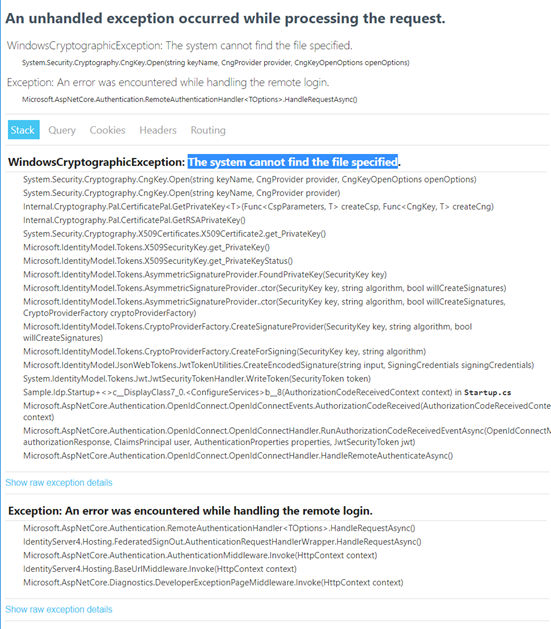Tech Blog
Since 2004
WindowsCryptographicException The system cannot find the file specified.

Azure – while trying to read pfx (certificate) from disk I came across a number of issues, but thought this might help some out.
- May 8, 2020
Rest of the Story:
Azure – while trying to read pfx (certificate) from disk I came across a number of issues, but thought this might help some out.
The fix was adding the final parameter X509KeyStorageFlags
var cert = new X509Certificate2(
$"{Environment.ContentRootPath}/App_Data/mycert.pfx","{password}",
X509KeyStorageFlags.MachineKeySet);
Other references:
https://support.microsoft.com/en-us/help/950090/installing-a-pfx-file-using-x509certificate-from-a-standard-net-applic https://stackoverflow.com/questions/52750160/what-is-the-rationale-for-all-the-different-x509keystorageflags
An unhandled exception occurred while processing the request.
WindowsCryptographicException: The system cannot find the file specified. System.Security.Cryptography.CngKey.Open(string keyName, CngProvider provider, CngKeyOpenOptions openOptions)
Exception: An error was encountered while handling the remote login. Microsoft.AspNetCore.Authentication.RemoteAuthenticationHandler<TOptions>.HandleRequestAsync()
Stack Query Cookies Headers Routing
WindowsCryptographicException: The system cannot find the file specified. System.Security.Cryptography.CngKey.Open(string keyName,
CngProvider provider, CngKeyOpenOptions openOptions)
System.Security.Cryptography.CngKey.Open(string keyName, CngProvider provider)
Internal.Cryptography.Pal.CertificatePal.GetPrivateKey<T>(Func<CspParameters, T> createCsp, Func<CngKey, T> createCng)
Internal.Cryptography.Pal.CertificatePal.GetRSAPrivateKey()
System.Security.Cryptography.X509Certificates.X509Certificate2.get_PrivateKey()
Microsoft.IdentityModel.Tokens.X509SecurityKey.get_PrivateKey()
Microsoft.IdentityModel.Tokens.X509SecurityKey.get_PrivateKeyStatus()
Microsoft.IdentityModel.Tokens.AsymmetricSignatureProvider.FoundPrivateKey(SecurityKey key)
Microsoft.IdentityModel.Tokens.AsymmetricSignatureProvider..ctor(SecurityKey key, string algorithm, bool willCreateSignatures)
Microsoft.IdentityModel.Tokens.AsymmetricSignatureProvider..ctor(SecurityKey key, string algorithm, bool willCreateSignatures,
CryptoProviderFactory cryptoProviderFactory)
Microsoft.IdentityModel.Tokens.CryptoProviderFactory.CreateSignatureProvider(SecurityKey key, string algorithm, bool willCreateSignatures)
Microsoft.IdentityModel.Tokens.CryptoProviderFactory.CreateForSigning(SecurityKey key, string algorithm) Microsoft.IdentityModel.JsonWebTokens.JwtTokenUtilities.CreateEncodedSignature(string input, SigningCredentials signingCredentials) System.IdentityModel.Tokens.Jwt.JwtSecurityTokenHandler.WriteToken(SecurityToken token) Sample.Idp.Startup+<>c__DisplayClass7_0.<ConfigureServices>b__8(AuthorizationCodeReceivedContext context) in Startup.cs
Microsoft.AspNetCore.Authentication.OpenIdConnect.OpenIdConnectEvents.AuthorizationCodeReceived(AuthorizationCodeReceivedContext context) Microsoft.AspNetCore.Authentication.OpenIdConnect.OpenIdConnectHandler.RunAuthorizationCodeReceivedEventAsync(OpenIdConnectMessage authorizationResponse, ClaimsPrincipal user, AuthenticationProperties properties, JwtSecurityToken jwt)
Microsoft.AspNetCore.Authentication.OpenIdConnect.OpenIdConnectHandler.HandleRemoteAuthenticateAsync()